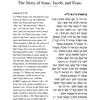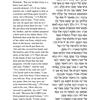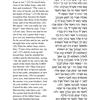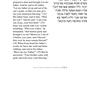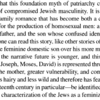4: Biblical excerpts, Genesis 27:1–35, and excerpt from academic article, Lori Hope Lefkovitz, 2002.
In sax’s poem, he makes reference to the Hebrew patriarch Isaac who was nearly sacrificed by his father: “no matter what was sacrificed / the tongued isaac / a son.” Isaac himself then goes on to have two sons, Jacob and Esau, who represent two very different strains of masculinity. As gender studies scholar Lori Hope Lefkovitz has argued, the story of Isaac and his two sons can be read as one of the foundational stories about Jewish masculinity and gender performance.
Suggested Activity: Review the Torah passage depicting Isaac blessing his sons Jacob and Esau, and the passage by scholar Lori Hope Lefkovitz (2002) offering insight into the story. Answer the following questions: If we consider Isaac’s sons, Jacob and Esau, to be symbolic representations of masculine identity in Jewish culture, how would you describe the man Jacob represents? What about Esau? Lefkovitz suggests that this story should be seen as a narrative about gender performance and, in particular, the need for the effeminate Jewish man to successfully pass as a hyper-masculine figure in order to get his inheritance. sam sax’s poem tells a similar story: that of a gay Jewish man who learns to sound straight in order to be accepted. Can you identify any further parallels between the story and the poem?
Journal your answers, then pair up with another student to share and discuss your thoughts. Did you answer many of the above questions similarly? What can you offer each other from your differing perspectives?
Sources: Genesis 27:1–35. Source sheet compiled by Sadie Gold-Shapiro using sefaria.org, 2019.
Lori Hope Lefkovitz, "Passing as a Man: Narratives of Jewish Gender Performance." Narrative 10, no. 1 (2002): 93.
Isaac, Jacob, and Esau
 Download image (759.49 KB)
Download image (759.49 KB) Isaac, Jacob, and Esau 2
 Download image (836.87 KB)
Download image (836.87 KB) Isaac, Jacob, and Esau 3
 Download image (830.36 KB)
Download image (830.36 KB) Isaac, Jacob, and Esau 4
 Download image (441.62 KB)
Download image (441.62 KB) Lori Hope Lefkovitz
 Download image (48.83 KB)
Download image (48.83 KB)

